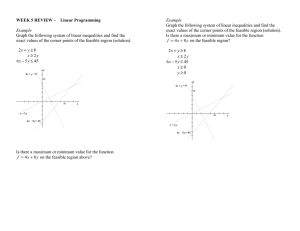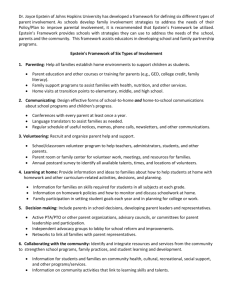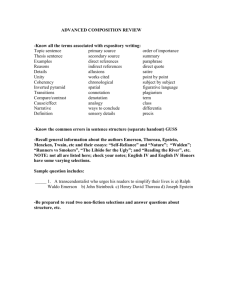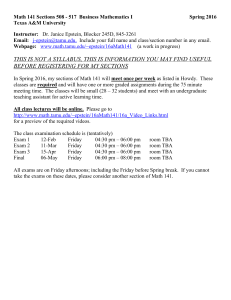WEEK 6 REVIEW – Linear Programming
advertisement
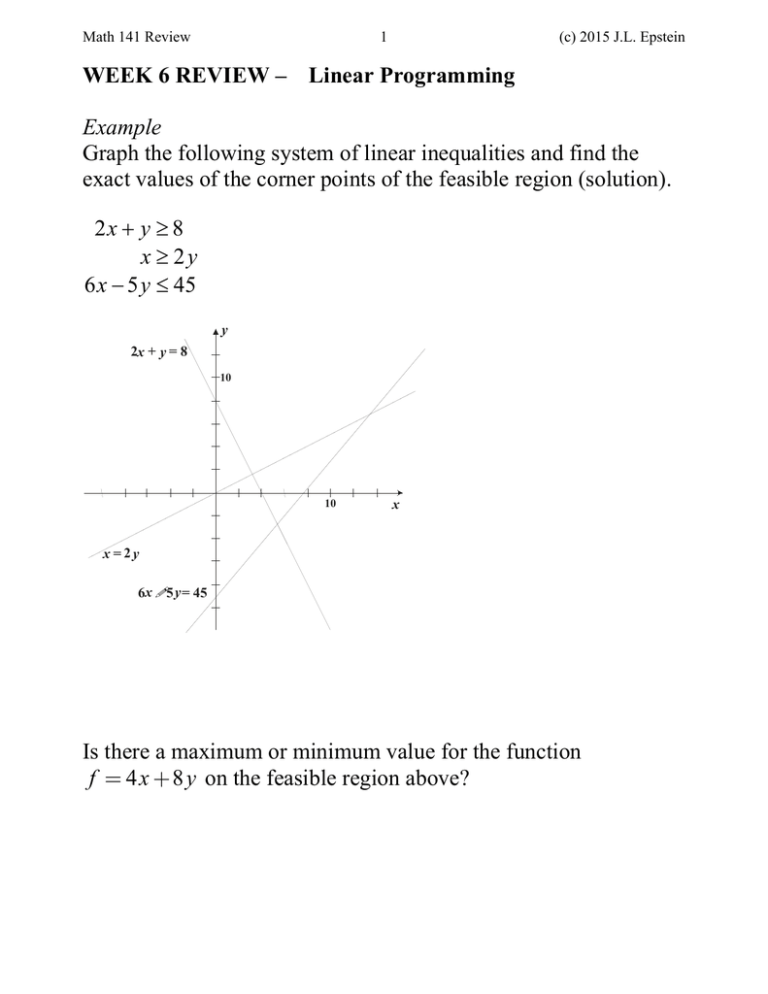
Math 141 Review 1 (c) 2015 J.L. Epstein WEEK 6 REVIEW – Linear Programming Example Graph the following system of linear inequalities and find the exact values of the corner points of the feasible region (solution). 2x y 8 x 2y 6 x 5 y 45 y 2x + y = 8 10 10 x x = 2y 6x 5 y = 45 Is there a maximum or minimum value for the function f = 4 x + 8 y on the feasible region above? Math 141 Review 2 (c) 2015 J.L. Epstein Example Graph the following system of linear inequalities and find the exact values of the corner points of the feasible region (solution). Is there a maximum or minimum value for the function f = 4 x + 8 y on the feasible region? 2x y 8 x 2y 6 x 5 y 45 x0 y0 y 2x + y = 8 10 10 x = 2y 6x 5 y = 45 x Math 141 Review 3 (c) 2015 J.L. Epstein Solving Linear Programming Problems Every linear programming problem has a feasible region associated with the constraints of the problem. These feasible regions may be bounded, unbounded or the empty set. To find the solution (that is, where the maximum or minimum value occurs), we will use the two theorems below. Theorem 1 If a linear programming problem has a solution, then it must occur at a vertex, or corner point, of the feasible set S, associated with the problem. Furthermore, if the objective function P is optimized at two adjacent vertices of S, then it is optimized at every point on the line segment joining these vertices, in which case there are infinitely many solutions to the problem. Theorem 2 Suppose we are given a linear programming problem with a feasible set S and an objective function P = ax + by. Case 1 If S is bounded, then P has both a maximum and a minimum value on S. Case 2 If S is unbounded and both a and b are nonnegative, then P has a minimum value on S provided that the constraints defining S include the inequalities x 0 and y 0. Case 3 If S is the empty set, then the linear programming problem has no solution; that is, P has neither a maximum nor a minimum value. Math 141 Review 4 Example Find the maximum value of f = 10 x + 8 y subject to 2 x + 3 y £ 120 5 x + 4 y £ 200 x ³ 0, y ³ 0 (c) 2015 J.L. Epstein Math 141 Review 5 (c) 2015 J.L. Epstein Example A workshop makes men’s and women’s watchbands out of leather and steel. Each men’s watchband uses 6 inches of leather and 9 grams of steel. Each women’s watchband uses 4 inches of leather and 3 grams of steel. The workshop has 48 inches of leather and 54 grams of steel available. If the men’s watchbands sell for $15 each and the women’s for $12 each, how many of each type of watchband should be made to maximize revenue? What is the maximum revenue? What, if anything, is leftover? Math 141 Review 6 (c) 2015 J.L. Epstein Example A dietician is planning a meal made from rice and beans. Each cup of rice has 3 grams of fiber and 250 calories. Each cup of beans has 10 grams of fiber and 220 calories. The patient needs at least 12 grams of fiber and the patient wants at least twice as much rice as beans. How many cups of each food should be in the meal to minimize the number of calories? Math 141 Review 7 (c) 2015 J.L. Epstein Example A gardener is ordering x pine trees and y oak trees. Pine trees provide two units of shade and oak trees provide three units of shade. The space and money constraints give a feasible region bounded by (0, 0), (0, 15) (12, 12), (21, 6) and (25, 0). How many of each type of tree should be ordered to maximize the amount of shade? Math 141 Review 8 (c) 2015 J.L. Epstein Example SET-UP, DO NOT SOLVE Mazie has at most $12000 to invest in three different stocks. The KO company costs $42.00 per share and pays dividends of $1.25 per share. The INTC company costs $21.00 per share and pays dividends of $0.40 per share. The MCD company costs $35.00 per share and pays $0.67 per share in dividends. Mazie has given her broker the following instructions: Invest at least twice as much money in INTC as in KO. Also, no more than 25% of the total invested should be in MCD. How should Mazie invest her money to maximize the dividends? Math 141 Review 9 (c) 2015 J.L. Epstein Example A company manufactures two types of wooden boats: dinghies and skiffs. To make each boat requires three operations: cutting, assembly and painting. The time required for each operation for each type of boat is summarized in the table below along with the available hours and the profit from each type of boat: cutting hours Dinghies 2 Skiffs 4 available 80 assembly hours 4 2 84 painting hours Profit 2 $60 2 $80 50 Determine the number of each type of boat that should be made to maximize the profit. What is the maximum profit? What, if anything, is leftover?
